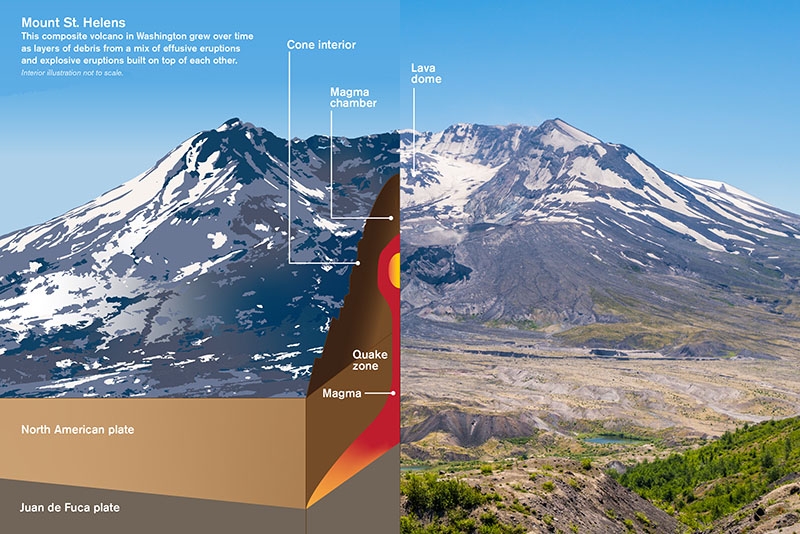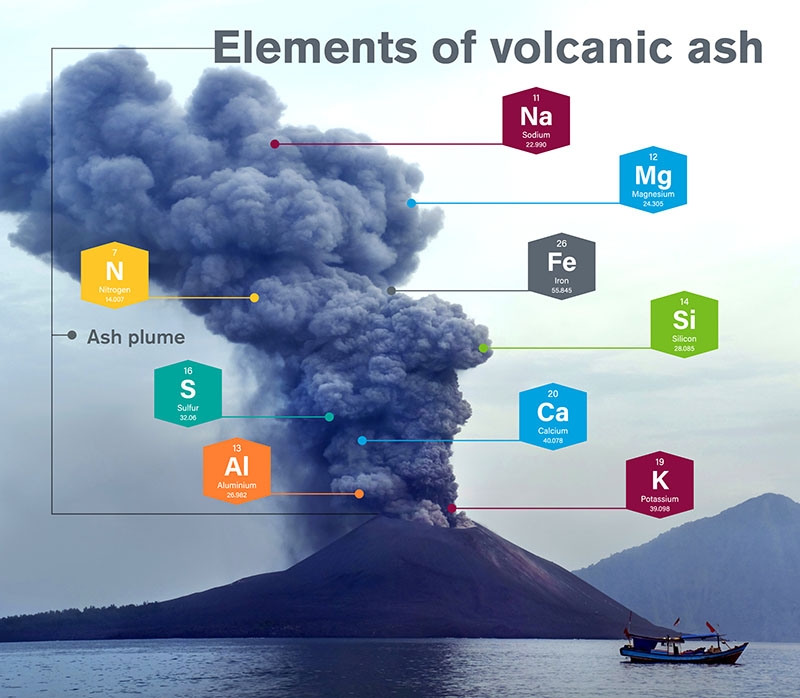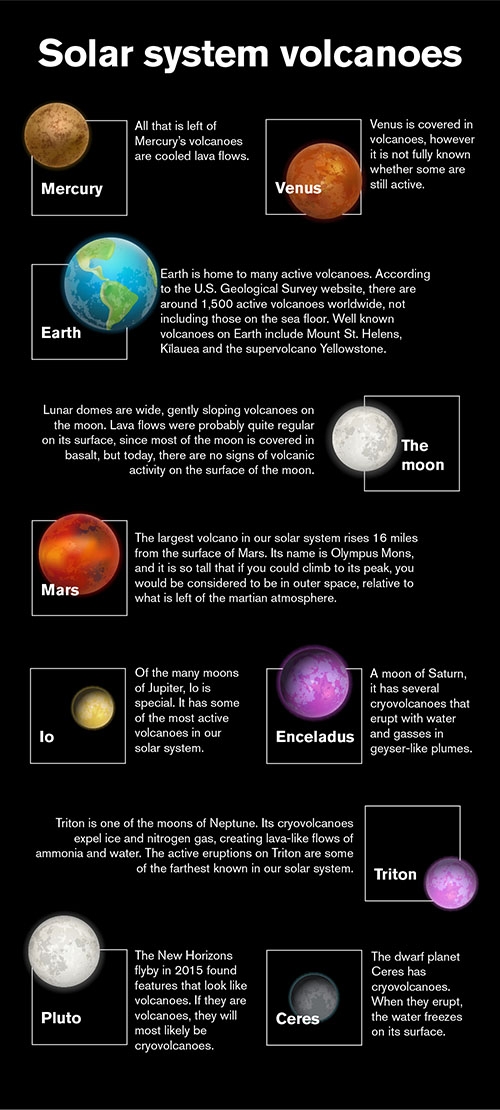Your burning questions about volcanoes, answered
ASU experts explain these molten mysteries

Volcano! That little word brings so much to our minds — streams of lava and clouds of ash, rumbling mountains, the might of a planet’s fiery underbelly, and our own nervous anticipation, curiosity and fear.
In fact, if it seems like more and more people have volcanoes on the brain, there’s a good reason.
It’s not necessarily that the number of volcanic eruptions is increasing, though media coverage of dangerous eruptions, such as the one in Indonesia on Aug. 10 or other recent ones in New Zealand and the Philippines, may make it appear that way. Scientists can’t say without more data from Earth’s history.
What is certain is that humans (and our stuff) take up more space on the planet than ever before, putting more people in the paths of volcanoes.
“The impact of volcanic eruptions is increasing,” volcanologist Amanda Clarke said. “As the global population grows, more people are being affected by eruptions, so we care about them more.”
Despite their growing effect on our lives, volcanoes seem to retain their air of mystery, leaving many of us with questions. Where do they come from? What causes eruptions? How do scientists predict them?
Clarke and fellow volcanologist Christy Till — both faculty in the Arizona State University School of Earth and Space Exploration — answer these questions and more to help us understand how to safely live in the shadows of these mighty forces of nature.
How does a volcano form?
There are two sides to the making of a volcano: what happens below ground and what happens above.
Events below ground have to do with plate tectonics. This is the theory that the Earth’s crust — the outer shell on which we live — is broken up into plates that move around on top of Earth’s mantle like ice cubes in a glass of water. Scientists see it as the force behind earthquakes, mountains, continent migration and volcano formation.
“Scientists for a long time have scratched their heads trying to figure out why these volcanoes occur where they do.”
— Christy Till
There are three basic types of tectonic environments where volcanoes grow.
The first is a convergent plate boundary, where two plates crash and an oceanic plate slips underneath another plate, bringing water and carbon dioxide into the mantle. This triggers a magma-melting process and creates more explosive volcanoes. This process created the Ring of Fire, an arch of volcanoes that wraps around the Pacific Ocean.
The second, a divergent plate boundary, occurs when a gap opens up between two plates. The gap is filled in by the mantle underneath, causing magma to melt. These volcanoes are common on the ocean floor and erupt continuously as the plates keep going their separate ways.
Volcanoes that form in the middle of a plate are called hot spot volcanoes.
“Scientists for a long time have scratched their heads trying to figure out why these volcanoes occur where they do,” Till said. “Our best guess is that there’s magma or mantle rising up underneath, and for some reason, it’s just hotter than in other places, so we get a volcano.”
Above ground, the part of the volcano we can see is formed by eruptions.
For example, Mount St. Helens, a composite volcano in Washington, grew over time as layers of debris from a mix of effusive eruptions (think gooey lava) and explosive eruptions (think pumice stone and ash) built on top of each other.
Sunset Crater, a cinder cone volcano in Arizona, ejected glowing fountains of lava and ash when it erupted, which then fell around the crater to create its steep slopes.
And Kilauea, a shield volcano in Hawaii, formed its wide but shallow slopes as its lava spread out in all directions and built up in layers over time.
However, the type of eruption, and therefore volcano, circles back to another underground element.
“The composition of the magma, and the process deep in the earth that forms it, controls the eruption style to a large extent,” Till said.
What is magma?
Magma is the molten material that sits under or inside the Earth’s crust. (Lava is magma that has reached the surface through a volcano.) Till’s lab, the Experimental Petrology and Igneous processes Center, looks at how magma forms on Earth and on other planets, as well as the underground processes that lead up to an eruption.
One of the surprises that researchers have learned in the last 10 years, she says, is that the magma below a volcano is not the cauldron of bubbling, liquid goo we might imagine.
“In fact, what’s below a volcano is more like a slushie. In a slushie, you have mostly ice crystals and some liquid, and at first, it’s hard to suck it through a straw because it’s mostly ice. You have to wait until it melts a little to get it through a straw.”
Magma, too, is composed of crystals (the geological kind) with just a little bit of liquid. Something must happen to the magma underground to warm it up, making it liquid enough to erupt. To study those processes, Till gathers samples of those crystals, which she likens to “little black boxes,” from volcanic deposits on the surface and examines them with microscopes.
“These crystals have little zones in them, much like tree rings. They can tell us about the temperature, pressure and composition of the magma chamber, and also how long before an eruption these specific events happened,” she said.
Video by ASU Research
What happens during a volcanic eruption?
First, a fresher, hotter, more liquid magma rises from deeper in the Earth’s mantle and warms the slushie magma in the volcano’s chamber. One way for it to arrive there is via an earthquake, which might push up fresh magma or open new pathways for it to travel upward. However, not every earthquake can warm a magma chamber and cause an eruption, Till notes.
“There’s also a possibility that the seismic waves passing through the crust can kind of jiggle a magma body and cause it to fizz. Just like with a soda, those bubbles can generate overpressure and buoyancy, driving an eruption,” Clarke said.
As the new and old magmas mix, the crystal mush heats up and comes to the surface. It could be an effusive eruption of syrupy, flowing lava, or it could be an explosive eruption of ash, cinders and hunks of molten rock known as lava bombs. The amount of gas in the body of magma determines how violent the eruption is.
For those that are more explosive, the volcano could generate an ash cloud that travels great distances, which could have indirect effects like roof damage, bad air quality or crop devastation. It could also unleash the significantly more destructive pyroclastic flow, which is a searing wave of dense ash and gases that rushes along the ground, killing and burning everything in its path.
“The plume is the big footprint, but only indirectly dangerous,” Clarke said. “The pyroclastic flows are the smaller footprint, but much more dangerous.”
If the volcano is near a body of water, there is another opportunity for additional destruction — pyroclastic flows entering the sea can cause tsunamis.
How do scientists predict eruptions?
“The bread and butter of prediction is seismic data,” Clarke said. Volcanologists take seismic stations, which measure vibrations in the earth, and distribute them all around a volcano to get the best read on what’s happening underneath.
Another important tool is the tiltmeter, which, as its name suggests, measures any miniscule changes in the level of the earth. Typically, before a volcano erupts, the ground around it inflates slightly, which scientists call deformation.
Observatories typically also monitor gas emissions, such as sulfur dioxide and carbon dioxide, which may indicate changes happening deeper in the volcano.
“If you want to know what a volcano is capable of doing in the future, the first thing you have to do is look at what it did in the past.”
— Amanda Clarke
And finally, cameras — both standard and thermal — help volcanologists keep an eye on activity. Clarke explains that thermal cameras are especially helpful for tall volcanoes whose tops may often be obscured by clouds.
“Using these kinds of data together, you can even predict how much magma there is, and at what depth,” Clarke said.
Having an idea of what a particular volcano can do once it’s ready to erupt is also a critical piece of prediction that allows volcanologists to make safety recommendations.
“If you want to know what a volcano is capable of doing in the future, the first thing you have to do is look at what it did in the past,” Clarke said.
Researchers do this by collecting ash deposits from a wide area and dating them. This gives them an idea of how large a volcano’s eruptions were and how frequently they occurred. However, the method has its limitations. Hardened magma is much harder to date than ash, and supervolcanoes have eruptions so large that the ash travels thousands of miles, making it difficult to determine their true size.
There’s also the trouble of inconsistent eruptions. Volcanoes tend to fluctuate in the size of their eruptions; a big one may be followed by several smaller ones before another large one happens. That’s why it’s crucial, Clarke said, to look over long timespans for an accurate picture of a volcano’s history.
How far in advance scientists can predict an eruption depends on a host of factors, one of which is whether the eruption is large or small. Large eruptions are farther apart, so they might have longer warning times — from weeks away to even decades — while the magma slowly heats up after the last eruption. Small eruptions are closer together, so their warning times are shorter — months to hours. However, an abundance of data means that those predictions are typically more precise than for large eruptions.
How can you stay safe in an area with volcanic activity?
Clarke has seen too many volcanic eruptions to count, but she says that her time on the island of Montserrat while getting her PhD was when she learned how to be safe around them.
“I think some people take a bit of a macho attitude about trying to get close to volcanoes,” she said.
Proper precautions, she argues, help people stay alive.
“The main thing is to understand what the local observatories and scientists are doing. They collect data. They know what’s going on,” she said.
Till has not experienced a volcanic eruption and, despite an academic interest in seeing one, is largely happy to keep it that way.
“I’ve been to volcanoes that could erupt at any time, but I was fortunate enough not to be there when they were erupting,” she said. Like Clarke, by checking in with observatories, she’s managed to keep herself safe in dangerous environments.
In the U.S., you can find the latest reports on activity at the U.S. Geological Survey website. Abroad, other nations may have an equivalent database online, or you can visit the Smithsonian’s Global Volcanism Program website, which gathers data from around the world.
These resources can help you find out what the alert level is in the area (and what colored or numbered alert system locals use), and whether there has been any activity recently. Clarke said it’s not a good idea to assume that other groups are communicating with the local observatory and recommends always checking for yourself.
“If you get a permit from the forest service to hike to a crater, that doesn’t mean it’s safe. That doesn’t mean they’ve checked the data.”
What do classifications like active, dormant and extinct mean?
Not much, it turns out.
Clarke explains that people used to classify a volcano as “active” if it had erupted in historic time. The problem with this is that historic time varies from culture to culture, because it refers to the time when written records became available. Volcanoes in Italy have extensive documentation going back thousands of years, but volcanoes in the U.S. don’t have as deep of a written history.
“Having had a historic eruption is a meaningless classification, because there’s no number that goes along with that,” Clarke said.
A dormant volcano is one that is active but not currently erupting, while an extinct volcano has not erupted in historic time and is unlikely to erupt in the future.
A handier — and globally applicable — way to determine if a volcano is active is whether it has erupted during the Holocene, our present epoch which began over 11,000 years ago. However, this marker ultimately has its own flaws. A volcano can have an incredibly long lifespan, sometimes lasting millions of years. Silence in recent millennia doesn’t mean its erupting days are over.
“Whether it erupted in the Holocene is meaningless when it comes to someplace like Yellowstone or the Valles Caldera, whose timescales are way longer than we even have the capacity to document,” Clarke said.
Can a volcanic eruption be stopped?
Ideas for stopping eruptions range from venting gases to relieve volcanic pressure to plugging the top like a cork in a bottle. However, these concepts remain untested, and most volcanologists don’t take such efforts seriously.
What has found some success, though, is using barriers to redirect lava and pyroclastic flows away from towns and important structures. Clarke gives the example of Heimaey, a harbor town in Iceland that experienced a nearby eruption in 1973. The resulting lava flow threatened to close off the bay that was their main economic resource.
“As it started to enter the bay, they got out all the water hoses they had and sprayed it, and it solidified there. They used the lava itself as a barrier,” Clarke said.
Do volcanoes affect the climate?
Volcanic eruptions have both positive and negative effects on the climate. For example, their plumes carry gases like sulfur dioxide, which reach above the clouds into the stratosphere. There, the gas forms into droplets of sulfuric acid.
“The sulfur compounds can be circulated around the globe, and they can filter out the sun’s light and heat to cool global temperatures,” Clarke said.
Researchers speculate that such an event — an 1815 eruption of Mount Tambora in Indonesia — was behind the 1816 “year without a summer” that caused low temperatures and heavy rains in Europe and North America, leading to food shortages.
Whether an eruption can have a worldwide effect may depend on the size and composition of the ash cloud, as well as the volcano’s position on Earth. The cooling effect is always temporary. The longest documented cooling period lasted about three years, though Clarke believes that super eruptions in Earth’s history may have had longer temperature effects.
If you’re thinking that this sounds like a good way to combat today’s warming temperatures, you’re not alone. Some scientists are beginning to research the possibilities of solar engineering — a strategy inspired by volcanoes that would use planes to spray sulfur dioxide into the stratosphere.
Another climate effect of volcanoes is that their ash makes super fertile soil, creating lush environments in the areas surrounding them. The plants and trees that grow in this rich soil capture and store carbon dioxide from the atmosphere.
“What’s in fertilizer? Phosphorus, nitrogen and potassium. Those are abundant in volcanic products,” Clarke said. “Basically, they act as a fertilizer just like you might buy at Agway or ACE Hardware.”
Nutrients from falling ash easily leach into the soil, she adds, making it an excellent delivery system as well.
What are volcanoes like on other planets?
Planets, and moons as well, can have volcanoes very different from those on Earth. Jupiter’s moon Io has more volcanic activity than any other object in our solar system; its lava fountains can be many miles high. And the dwarf planet Ceres has ice volcanoes, or cryovolcanoes. They erupt water instead of magma, which freezes on its surface.
“The compositions of planets are different, so the kinds of magma they have are different, which then gives them unique eruptive behavior,” Till said.
Her lab works to understand the magma of other celestial bodies by creating it in a special device called a piston cylinder, which simulates conditions on the interior of a planet.
“In the same way that you’d mix flour and sugar and eggs to make a cake, we mix silica and magnesium and iron and other elements in the proportion we want to study. Then we put them in our equivalent of an oven to make magma at high pressures and temperatures,” Till said. “When we do this, we can discover how magmas on other planets are different.”
Her team has begun work on a new project that will study the types of magma that may exist on planets outside our solar system, known as exoplanets. Knowing more about their magma will give researchers glimpses into those planets’ volcanic behavior.
“Over 4,000 exoplanets have been confirmed in the last five years or so, and we’re just starting to investigate them,” Till said. “It’s an exciting time.”
Top photo from Shutterstock.
More Science and technology

Miss Arizona, computer science major wants to inspire children to combine code and creativity
Editor’s note: This story is part of a series of profiles of notable spring 2024 graduates. “It’s bittersweet.” That’s how Tiffany Ticlo describes reaching this milestone. In May, she will graduate…

ASU applied behavior analysis program recognized in Four Corners region
Helping students with learning disabilities succeed in school and modeling effective communication skills are just two examples of how applied behavioral analysis improves lives. Since launching…

Redefining engineering education at West Valley campus
Editor's note: This story originally appeared in the summer 2024 issue of ASU Thrive magazine. What makes the School of Integrated Engineering different from other engineering schools? We listened…


